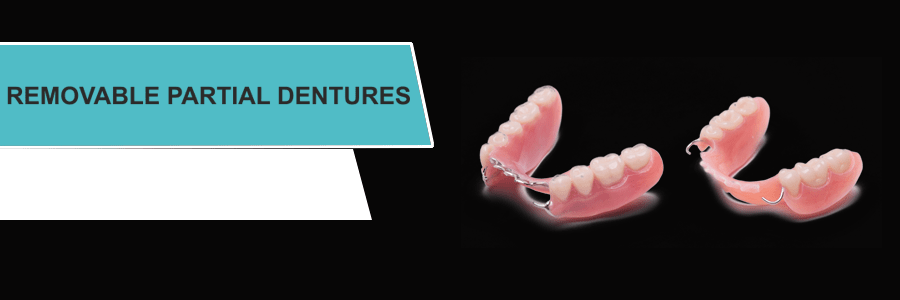
Missing teeth replacement
A removable partial denture (missing teeth replacement) or bridge usually consists of replacement teeth attached to a pink or gum-colored plastic base, which is sometimes connected by metal framework that holds the denture in place in the mouth. Partial dentures are used when one or more natural teeth remain in the upper or lower jaw. A fixed bridge replaces one or more teeth by placing crowns on the teeth on either side of the space and attaching artificial teeth to them. This “bridge” is then cemented into place. Not only does a partial denture fill in the spaces created by missing teeth, it prevents other teeth from changing position. A precision partial denture is removable and has internal attachments rather than clasps that attach to the adjacent crowns. This is a more natural-looking appliance.
Restrictions of Conventional Partial Dentures
Esthetics – it is not always possible to hide the metal clasps required to hold the denture in place
Support – a partial denture is only as strong as the teeth it clasps to, thus just because a patient has remaining teeth, the teeth may not be strong enough to support the forces placed on them by a partial denture
Stability – depending on what (or how many) teeth are being replaced by the denture, a partial may rock up and down while chewing and/or speaking
Advantages of Conventional Partial Dentures
Cost – conventional partial dentures are the least expensive way to replace missing teeth
Flexibility – occasionally, partial dentures can have teeth and clasps added to them if other teeth require extraction in the future
How to Care for Partial Dentures
Partial dentures, like your natural teeth, just need thorough and regular brushing in order to remove food deposits and dental plaque. Unlike your natural teeth, partial dentures are very delicate and break easily, so it’s important to handle them with care.
Caring for your dentures
• When cleaning a partial denture, it’s a good idea to stand over a folded towel or a sink of water just in case you accidentally drop the denture.
• Do not use toothpaste since it can be too harsh for cleaning dentures.
• Some people use hand soap or mild dishwashing liquid to clean their dentures, which are both acceptable. However, most household cleaners are too abrasive and should not be used for cleaning dentures.
• Brush the denture each day to remove food deposits and plaque. The helps the denture from becoming permanently stained.
• It’s best to use a brush that is designed for cleaning dentures because it has bristles that are arranged to fit the shape of the denture. A regular, soft-bristled toothbrush is also acceptable.
• Avoid using a brush with hard bristles, which can damage the denture.
• Clean your dentures by thoroughly rinsing off loose food particles. Moisten the brush and apply the denture cleaner. Brush all denture surfaces gently to avoid damaging the plastic or bending the attachments.
• A denture could lose its proper shape if it is not kept moist. At night, the denture should be placed in soaking solution or water. Your dentist can recommend the proper method for keeping your dentures in good shape.
• Don’t chew, swallow, or gargle with denture cleansers.
• Always thoroughly rinse the denture before placing it in your mouth.
